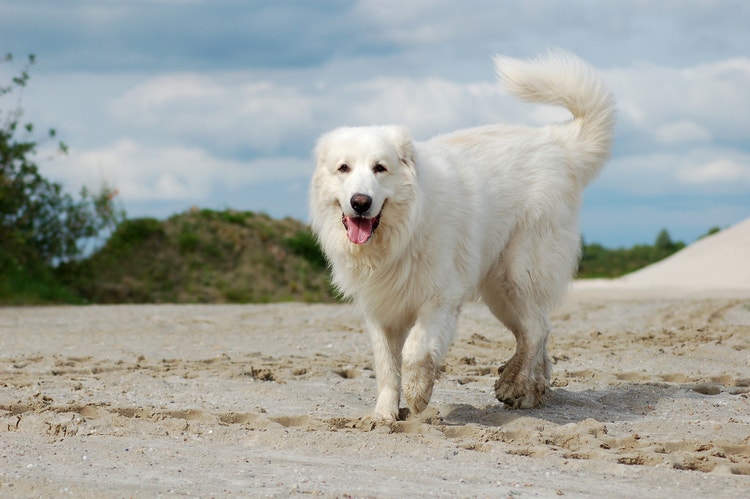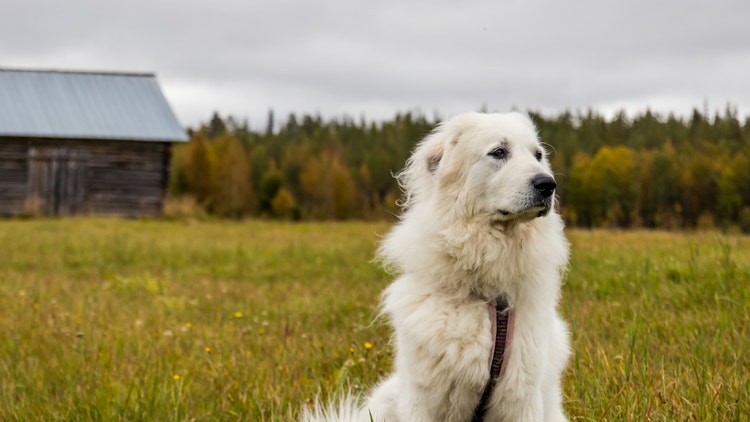
Great Pyrenees


Where Are Great Pyrenees Dogs From?
The Pyr is believed to have originally descended from the Mastiff breeds of Asia or Siberia. They are one of the oldest natural breeds, having followed the human migration into Europe, eventually settling in the Pyrenees mountains between Spain and France. For the next several centuries, the Pyr served as flock guardians, fending off fearsome predators, such as bears and wolves; their success earned them the nicknames the Pyrenean Wolf Dog and the Pyrenean Bear Hound. They were often fitted with iron collars adorned with large spikes to protect their necks. Combine this with the protection of their thick coats, and this breed was nearly unbeatable.
In the 17th century, the Pyr gained popularity with French nobility, and were often seen at court. Around the same moment in history, the first settlers of Newfoundland brought Great Pyrenees with them, to provide companionship as they discovered uncharted territory. Here, they were cross bred with English Retrievers, creating the Newfoundland breed.
With the decrease in the predator population in the mountains of France, the Pyr came dangerously close to extinction in the early 20th century. They experienced a resurgence of numbers after they were brought to America, and were eventually accepted by the AKC in 1933.
Caring for a Great Pyrenees
What Kind of Diet Does a Great Pyrenees Need?
What Kind of Diet Does a Great Pyrenees Need?
Due to their relatively slow metabolism, the Great Pyrenees does not eat as much food as one might think. Feeding a large-breed formula food with a low-protein content is ideal. They are prone to gastric dilatation volvulus (GDV or bloat), so it may be helpful to feed smaller, more frequent meals and to avoid exercise around mealtime.
How Much Grooming Does a Great Pyrenees Need?
How Much Grooming Does a Great Pyrenees Need?
Despite their impressively fluffy coat, Great Pyrenees do not require excessive grooming. Brushing a few times weekly is typically sufficient, except during seasonal shedding periods. Trim nails regularly, paying special attention to the double dewclaws on the hind feet, as overgrown nails can become quite uncomfortable.
Are Great Pyrenees Healthy Dogs?
Are Great Pyrenees Healthy Dogs?
Great Pyrenees are typically healthy, with an average lifespan of 10 – 12 years. They should be evaluated for hip and elbow dysplasia as they are prone to arthritis in these joints.
Pyrenees are predisposed to: gastric dilatation volvulus (GDV or bloat), hip dysplasia, elbow dysplasia, chronic valvular heart disease, luxating patella, atopy, entropion, epilepsy, and otitis externa.
Can You Train a Great Pyrenees?
Can You Train a Great Pyrenees?
Great Pyrenees were bred to work independently while guarding livestock, as such, they tend to become bored with standard training procedures (items like sit, stay, and heel). As puppies, they will need training and early socialization to avoid aggression toward unknown animals and people. If you spend time on training your Pyr, you will have a great companion and protector in the family.
How Much Exercise Does a Great Pyrenees Need?
How Much Exercise Does a Great Pyrenees Need?
Great Pyrenees do not require more than moderate exercise. They were bred to monitor their territories, only expending energy to fend off predators. They are occasionally referred to as “mat dogs,” as they enjoy spending time laying outside when not working. Don’t be fooled by this apparent laziness, for their eyes, ears, and nose are always on guard!
What Are Physical Characteristics of a Great Pyrenees?
Great Pyrenees Facts
Other Breeds to Explore
References
- American Kennel Club. The Complete Dog Book. Random House Digital, Inc., 2006.
- Morris, Desmond. Dogs: The Ultimate Dictionary of Over 1,000 Dog Breeds. Trafalgar Square, 2002.
- Wilcox, Bonnie and Chris Walkowicz. The Atlas of Dog Breeds of the World. T.F.H. Publications, Inc., 1995.


